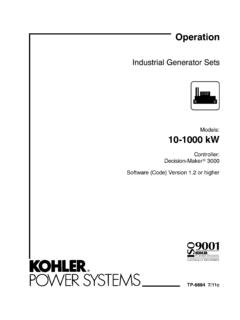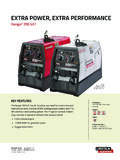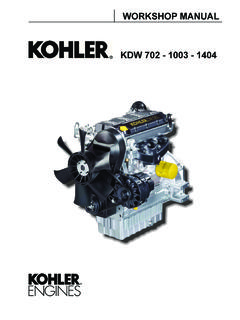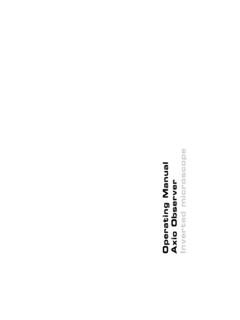Transcription of Building a Hot-Rod Kohler K301 - Kirk Engines, Inc.
1 Building a Hot-Rod Kohler K301 For an IH Cub Cadet Garden Tractor Posted by David Kirk on 5-29-01 through 5-31-01 Loud pipes save lives! Actually, this picture shows the first test run of a modified Kohler K301 I built up for my 1250 Cub Cadet. It was a winter project, so I took my time and put together a hot rod Kohler , something I've wanted to do for a long time. The modifications are typical for L-head (flathead) engines and in this article I'll try and describe what I did and show pictures of the parts as the engine went together. Now the obvious question is "why not install a K321 (14 hp) or K341 (16 hp) engine if you wanted more power? First of all, I like the K301 as it is the "small block" of the stroke engine series. The small bore means low reciprocating mass, thus smoother running, and better cooling as the same flywheel (hence cooling fan) is used on all three engines. Secondly, it is the right engine to be installed in the 1250. Third, the challenge of making the K301 perform (hopefully) as well as the K341 is reason enough.
2 Fourthly, I am a frustrated hot rodder at heart that can't afford to build a full house V-8, but the next best thing is a Killer Kohler for my Cub! I purchased a rather worn K301 AQS engine from a local used parts supplier. Teardown revealed that cylinder bore and crankpin were worn, but this was to be expected. The block was the first and most important item that I started work on. I had the cylinder bored .010 over and the valve seats re-cut, this work being done by the local automotive machine shop. I then ported and polished both inlet and exhaust runners using a hand grinder. Both inlet and exhaust valve pockets (on the block deck) were radiused and blended into the deck surface, known as a "partial relief" in flathead terms. These modifications remove some of the restrictions to gas flow, allowing better breathing and ultimately, better performance. At the carburetor mounting surface, Kohler provided a lead-in chamfer that attempts to correct for possible carburetor misalignment to the inlet port.
3 On a production line-built engine this is a good feature, but for a hand built engine, it can be improved upon. The chamfer forms a discontinuity that is disruptive to gas flow. Thus to correct this, the carb thermal isolator was screwed down to the block and JB Weld used to fill up this chamfer. After hardening, and using the isolator as a template, the excess was hand-ground away. The result was a perfect uniform blend from isolator to inlet port diameter. Also not shown in the picture is the amount of casting flash that was eliminated between the cooling fins and the valve port areas in the cooling air circuit. Several hours were spent with a hacksaw blade and rat-tail file getting this flash removed. Remember, higher power outputs create higher heat loads and you want nothing to hinder the cooling airflow in a hi-performance air-cooled engine. The block was then immersed in an ultrasonic cleaner with hot soapy water and allowed to soak for several hours. It came out hospital clean, and had a nice golden color on all the machined surfaces.
4 It was then masked and painted with flat black engine paint that must be baked at 400 deg F to set properly. An industrial oven was used for this. You don't dare use the wife's the pizza a funny aftertaste. Total time spent on the block - about 20 hours. This is another (blurry) picture of the block from the intake port side, showing the thermal isolator attached. Standard carburetor mounting bolts were replaced with studs and hi-temperature lock nuts. The cylinder head was bead-blasted all over and left unpainted, as was the oil pan and bearing plate. Bare aluminum parts will dissipate heat better than when painted. The head was decked .040 raising compression ratio to :1. The spark plug hole was blended into the combustion chamber roof by careful radiusing using a hand grinder and an old spark plug as a gauge. Next in the build up of the Killer Kohler was the crankshaft. It was sent out to have the crankpin ground .010 under, as it had worn out of service limits for a standard rod.
5 After getting it back, it was polished all over using a hand grinder. The finish reduces windage losses but more importantly, a smooth surface is less prone to fail due to reduced stress concentrators. After polishing, a coat of Hoppe's gun bluing was applied to make it look nice and prevent rusting. The crankpin was left un-blued, but polished with 600-grit emery cloth (lightly). Total time on this part - about 4 hours. The next important component is the connecting rod. Don Vogt (a highly respected engine builder) turned me on to this one. Kohler made an 18 hp version of the K341, which they called the K361. It was a K341 with overhead valves. But the con rod used in this engine is an Alcoa aluminum FORGING instead of the standard die-cast part. Best of all, this lovely rod fits right into the other engines perfectly. It has the same external dimensions, center distances, and mass as the die-cast rod. The Kohler part numbers are: 45-067-16 for std. crankpin diameter 45-067-18 for.
6 010 under crankpin diameter This rod is a must for a high-performance engine, unless you want to spend more on a fully machined billet rod from Midwest Super Cub. The Kohler part will set you back about $100 but it's good insurance against failure. The outer shanks of the rod were polished to an almost mirror finish, again to reduce stress risers. The oil hole (to the crankpin bearing) was chamfered, and all sharp external corners and edges were radiused. The oil dipper leading edge was sharpened as well. Total time to prepare this part - about 3 hours. The piston I decided on using is also a Kohler part. The service manual identifies this type of piston as style "D". Mahle, the premier piston manufacturer, known worldwide for their state-of the-art components, makes it. The air-cooled Porsche 911 engine has utilized Mahle cylinders and pistons for many years. This particular piston, Kohler P/N 47-874-18 (.010 oversize) has a cam and taper ground skirt, recessed pin bosses for a short (and therefore light) wrist pin, and just looks robust and modern compared to the other styles of pistons available.
7 It is supplied with the wrist pin, pin retainers, and piston rings. The top compression ring is chromed, iron second comp ring, and a 3-piece steel rail-expander oil ring is used. This part is good to go right out of the box - no special prepping required. The book specified a skirt-to-cylinder wall clearance of .0045 to .0062. I chose .005, about right in the middle of the tolerance band, and had the cylinder bored to obtain this clearance. Remember, this engine will be used for mowing and snow throwing so must have a good life span. As for the camshaft, I learned from Cub Cadet dealer Scott Madson, that he has a supplier that regrinds cams to quarter scale puller rule specifications. Referred to as a cheater cam, you supply your cam to Scott along with $55, wait two weeks, and it is returned via UPS right to your shop doorstep. This price is very reasonable compared with cams from other suppliers, running in the hundreds of dollars. The cams are recarburized, and the surface finish appeared very smooth.
8 When a cam is reground, the base circle gets smaller and this throws the geometry of the compression release off a bit. Thus a little rework is necessary here and involves hand grinding and radiusing the sharp edges on the "tab". Final tweaking and bending of the tab is necessary after valve train and cam are assembled in the block. The cam lobes were polished with a ScotchBrite pad before assembly, thus removing some of the scale that remained from carburizing. I degreed this cam after assembly and it's noticeably more aggressive in duration and overlap, but lift is same as stock at approximately .312. The valve opening and closing acceleration rates are higher than original as well.. Total time spent on the camshaft - about 2 hours For lifters, I chose these large base parts available from Midwest Super Cub for $10 each. While a large base lifter was not really necessary with this cam, the original lifters showed some wear and needed replacing anyway. These parts are actually lifters from a Wisconsin engine that just happen to fit a Kohler .
9 After assembly, I found that the lifters were too long and held the valves off the seats slightly. I had to surface-grind down the adjusting screws approximately .060 to allow ample clearance. Next in the Kohler build-up is the valve train. The springs, retainers, keepers, and valves are stock Kohler parts. I used the more expensive Stellite exhaust valve, P/N 235838 for good durability. Both valves were swirl-polished. They were then chucked in the drill press and, using a file, the lower edge corner (that meets with the 45 degree seat surface) was radiused slightly. This has shown to raise airflow some 5% when tested on a flow bench. Not as trick as a 3 angle valve job, but nevertheless, better than stock. The exhaust valve used in the K321 and 341 is larger than the K301 part. It was tempting to spend the extra money in machining costs to refit the block with this larger valve. But some basic calculations on valve curtain area to available port cross section area showed minimal potential benefits.
10 Thus, I decided to stay with the stock component. This picture shows the engine starting to go together. I've found that a standard automotive engine stand works just fine for the Kohler too. Here the stator is bolted into place. I used grade 8 socket head screws with Loctite instead of the stock slotted head screws. Note that the bearing plate is left unpainted, as well as the other aluminum components. Here the oil pan, dipstick tube, and head are bolted on and carefully torqued to book specs. I know it s anal, but I paint both sides of the flywheel (after masking off the magnets). Don't like the thought of bare iron rusting! Final assembly is almost complete. Note the billet aluminum breather cover with a "road draft tube"! I got tired of dandelion seeds and grass clippings sticking to the oil film that invariably gets on this side of the engine from the stock breather slot. I designed the cover and a machinist friend with an N/C mill made it for me.











